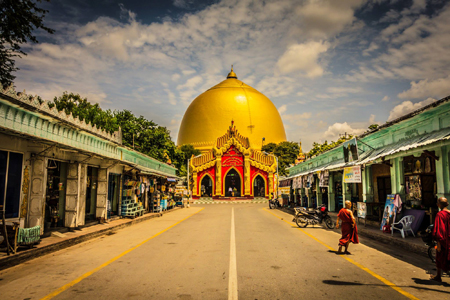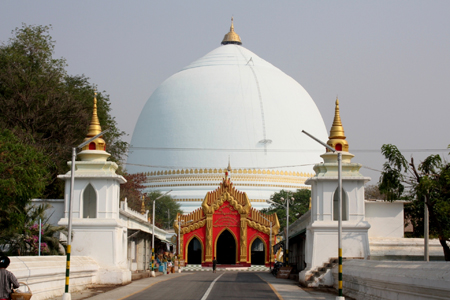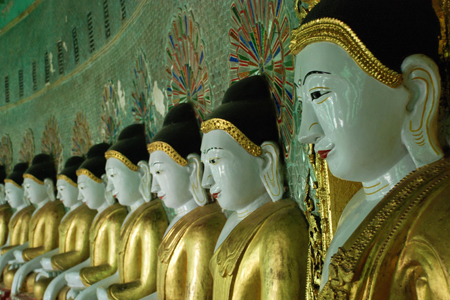Not very far from Mandalay, Sagaing is a mesmerizing hill consists of hundreds of stunning pagodas, stupas, and monasteries. With so many things to discover, this is one of the interesting places to visit in Myanmar trips. In this article, get more insights into this extraordinary land.
After the fall of Bagan, Athinkhaya Sawyun, son of the youngest of the three Shan brothers founded Sagaing in 1315. It lies on the right bank of the Ayeyarwady. It has no great place in history as the capital was moved to Innwa by Thadominbya after 50 years. Alaungpaya’s eldest son Naungdawgyi had his capital again at Sagaing for four years (1760-64) and when he died Innwa once again became the seat of royalty. The place is, however, one of the most picturesque sites of Myanmar with numerous pagodas crowning the tops of the hills at the back.
Among the notable pagodas at Sagaing is the Htupayon built by Narapatigyi (1443-1469) of Innwa. On the occasion of the hti-hoisting ceremony, the king constructed a temporary wooden bridge across the river and the festival was attended by thousands of citizens with great rejoicing. It was destroyed by the earthquake of 1838 and king Bagan began reconstructing it in 1849 but was left unfinished when he was dethroned. It has a circular plan with three concentric storeys adorned with arched niches. Once again its reconstruction has been taken up recently by public donations under the sponsorship of an enthusiastic monk. Sagaing abounds with contemporary inscriptions which are collected and preserved in sheds near this pagoda. The dedicatory inscription of this pagoda itself is properly housed in a masonry shrine.
The Hsinmyashin pagoda enshrining some relics from Ceylon was built by King Monhyin of Innwa in 1429. It was damaged by an earthquake in 1485 and was repaired by Minkhaung II. However, it was once again razed to the ground by another severe quake in 1955 and reconstruction is still in progress. Invaluable and interesting images and votive tablets recovered from the relic chamber are now exhibited there and will be re-enshrined when it is completed.
A few miles to the north of the town is the Kaunghmudaw (Rajamanicula) pagoda built by King Thalun in 1636 on the model of the Mahaceti pagoda of Ceylon in commemoration of the re-establishment of Innwa. The shrine composed of three circular terraces and a gigantic dome towers to a height of 151 feet. It enshrines the tooth relic of Buddha brought from Ceylon and attracts the veneration of the masses. A marble inscription, 8l feet high, which records the details regarding the erection of this pagoda is well preserved in masonry shed on the platform.
The Aungmyelawka pagoda near the Htupayon was erected by Bodawpaya (1782-1819) on the site of his residence before he ascended the throne. It was built entirely of stone on the model of the Shwezigon Pagoda at Bagan. The Ngadatkyi pagoda contains a very large seated image of Buddha. It was built in 1657 by Pindale, son, and successor of King Thalun.
Noteworthy pagodas on the hills are the Ponnyashin zedi, said to have contained two relics of Buddha, the Padamya zedi built by a monk called Padugyi Thingayaza in 1300, and Onhmin Thonze (thirty caves) pagoda consisting of many images of Buddha enshrined in a crescent-shaped colonnade on the side of the hills. The Tilawkaguru cave temple, said to have been built about 1672 by Narawara of the second dynasty of Innwa, contains mural paintings depicting scenes from the former lives of the Buddha. These are rare specimens of the artistic achievement of the Innwa period.
Of comparatively late establishment are the Sagaing fortress and the iron smelting factory which was abandoned before it could be usefully operated on the British annexation of Upper Myanmar.
- Get link
- X
- Other Apps
Labels
About Myanmar Pagodas Sagaing- Get link
- X
- Other Apps


